Module 6 Manage International Marketing Programs Assessment Term and Year: 2019 Qualification: BSB60215 Advanced Diploma of Business Unit Code: BSBMKG606
Added on 2022-10-17
25 Pages5902 Words349 Views
Module 6
Term and Year: Term 3 2019
Qualification : BSB60215 Advanced Diploma of Business
Unit Code: BSBMKG606
Unit Title: Manage International Marketing Programs
Assessment :
Task 1 Short questions based on case scenario
Task 2 Demonstration & observation - presentation
Student Name:
Student ID No:
Assessor’s Name: Svetlana Arutyunyan/ Andrey Loburets
Student Declaration: I declare that this work has been completed by me honestly and with integrity. I understand that the Elite
Education Vocation Institute’s Student Assessment, Reassessment and Repeating Units of Competency Guidelines apply to
these assessment tasks.
Student Name:
Student Signature: Date:
Assessment submission (new) requirements
Please save this file as PDF format (include your name to the filename) before uploading onto Moodle.
Assessment deadlines penalty
It is expected that unless a simple extension, special consideration or disability services adjustment has been granted,
candidates will submit all assessments for a unit of study on the specified due date. If the assessment is completed or
submitted within the period of extension, no academic penalty will be applied to that piece of assessment.
If an extension is either not sought, not granted or is granted but work is submitted after the extended due date, the late
submission of assessment will result in a late penalty fee. For further information, please refer to the Assessment Policy.
Assessment/evidence gathering conditions
Each assessment component is recorded as either Satisfactory (S) or Not Yet Satisfactory (NYS). A student can only achieve
competence when all assessment components listed under procedures and specifications of the assessment section are
Satisfactory. Your trainer will give you feedback after the completion of each assessment. A student who is assessed as NYS is
eligible for re-assessment. Should the student fail to submit the assessment, a result outcome of Did Not Submit (DNS) will be
recorded.
V2018.T3. 1.1
BSB60215 Advanced Diploma of Business/ BSBMKG606/ 2018/ T3/ Assessment Tool/ Task 1 & 2 Page 1 of 25
Term and Year: Term 3 2019
Qualification : BSB60215 Advanced Diploma of Business
Unit Code: BSBMKG606
Unit Title: Manage International Marketing Programs
Assessment :
Task 1 Short questions based on case scenario
Task 2 Demonstration & observation - presentation
Student Name:
Student ID No:
Assessor’s Name: Svetlana Arutyunyan/ Andrey Loburets
Student Declaration: I declare that this work has been completed by me honestly and with integrity. I understand that the Elite
Education Vocation Institute’s Student Assessment, Reassessment and Repeating Units of Competency Guidelines apply to
these assessment tasks.
Student Name:
Student Signature: Date:
Assessment submission (new) requirements
Please save this file as PDF format (include your name to the filename) before uploading onto Moodle.
Assessment deadlines penalty
It is expected that unless a simple extension, special consideration or disability services adjustment has been granted,
candidates will submit all assessments for a unit of study on the specified due date. If the assessment is completed or
submitted within the period of extension, no academic penalty will be applied to that piece of assessment.
If an extension is either not sought, not granted or is granted but work is submitted after the extended due date, the late
submission of assessment will result in a late penalty fee. For further information, please refer to the Assessment Policy.
Assessment/evidence gathering conditions
Each assessment component is recorded as either Satisfactory (S) or Not Yet Satisfactory (NYS). A student can only achieve
competence when all assessment components listed under procedures and specifications of the assessment section are
Satisfactory. Your trainer will give you feedback after the completion of each assessment. A student who is assessed as NYS is
eligible for re-assessment. Should the student fail to submit the assessment, a result outcome of Did Not Submit (DNS) will be
recorded.
V2018.T3. 1.1
BSB60215 Advanced Diploma of Business/ BSBMKG606/ 2018/ T3/ Assessment Tool/ Task 1 & 2 Page 1 of 25
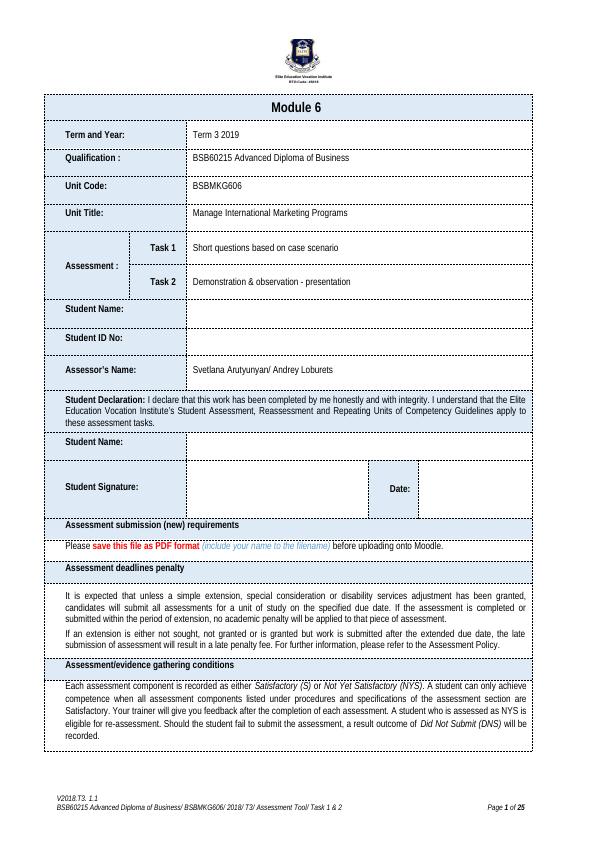
Principles of Assessment
Based on Clauses 1.8 – 1.12 from the Australian Standards Quality Assurance’s (ASQA) Standards for Registered Training
Organizations (RTO) 2015, the learner would be assessed based on the following principles:
Fairness - (1) the individual learner’s needs are considered in the assessment process, (2) where appropriate, reasonable
adjustments are applied by the RTO to take into account the individual leaner’s needs and, (3) the RTO informs the
leaner about the assessment process, and provides the learner with the opportunity to challenge the result of the
assessment and be reassessed if necessary.
Flexibility – assessment is flexible to the individual learner by; (1) reflecting the learner’s needs, (2) assessing competencies held
by the learner no matter how or where they have been acquired and, (3) the unit of competency and associated
assessment requirements, and the individual.
Validity – (1) requires that assessment against the unit/s of competency and the associated assessment requirements covers the
broad range of skills and knowledge, (2) assessment of knowledge and skills is integrated with their practical
application, (3) assessment to be based on evidence that demonstrates that a leaner could demonstrate these skills
and knowledge in other similar situations and, (4) judgement of competence is based on evidence of learner
performance that is aligned to the unit/s of competency and associated assessment requirements.
Reliability – evidence presented for assessment is consistently interpreted and assessment results are comparable irrespective of
the assessor conducting the assessment
Rules of Evidence
Validity – the assessor is assured that the learner has the skills, knowledge and attributes, as described in the module of unit of
competency and associated assessment requirements.
Sufficiency – the assessor is assured that the quality, quantity and relevance of the assessment evidence enables a judgement to
be made of a learner’s competency.
Authenticity – the assessor is assured that the evidence presented for assessment is the learner’s own work. This would mean that
any form of plagiarism or copying of other’s work may not be permitted and would be deemed strictly as a ‘Not Yet
Competent’ grading.
Currency – the assessor is assured that the assessment evidence demonstrates current competency. This requires the
assessment evidence to be from the present or the very recent past.
Resources required for this Assessment
All documents must be created using Microsoft Office suites i.e., MS Word, Excel, PowerPoint
Upon completion, ensure that you have completed your coversheet details, i.e. your name, student ID and signature. If these
details are not present, the assessment would need to be resubmitted again.
The document is then required to be converted to PDF and uploaded to the student learning management system for
assessment.
Refer the notes on eLearning to answer the tasks or any additional material will be provided by Trainer.
Instructions for Students
Please read the following instructions carefully
This assessment is to be completed according to the instructions given by your assessor.
Students are allowed to take this assessment home.
Feedback on each task will be provided to enable you to determine how your work could be improved. You will be provided
with feedback on your work within 2 weeks of the assessment due date.
Should you not answer the questions correctly, you will be given feedback on the results and your gaps in knowledge. You will
be given another opportunity to demonstrate your knowledge and skills to be deemed competent for this unit of competency.
V2018.T3. 1.1
BSB60215 Advanced Diploma of Business/ BSBMKG606/ 2018/ T3/ Assessment Tool/ Task 1 & 2 Page 2 of 25
Based on Clauses 1.8 – 1.12 from the Australian Standards Quality Assurance’s (ASQA) Standards for Registered Training
Organizations (RTO) 2015, the learner would be assessed based on the following principles:
Fairness - (1) the individual learner’s needs are considered in the assessment process, (2) where appropriate, reasonable
adjustments are applied by the RTO to take into account the individual leaner’s needs and, (3) the RTO informs the
leaner about the assessment process, and provides the learner with the opportunity to challenge the result of the
assessment and be reassessed if necessary.
Flexibility – assessment is flexible to the individual learner by; (1) reflecting the learner’s needs, (2) assessing competencies held
by the learner no matter how or where they have been acquired and, (3) the unit of competency and associated
assessment requirements, and the individual.
Validity – (1) requires that assessment against the unit/s of competency and the associated assessment requirements covers the
broad range of skills and knowledge, (2) assessment of knowledge and skills is integrated with their practical
application, (3) assessment to be based on evidence that demonstrates that a leaner could demonstrate these skills
and knowledge in other similar situations and, (4) judgement of competence is based on evidence of learner
performance that is aligned to the unit/s of competency and associated assessment requirements.
Reliability – evidence presented for assessment is consistently interpreted and assessment results are comparable irrespective of
the assessor conducting the assessment
Rules of Evidence
Validity – the assessor is assured that the learner has the skills, knowledge and attributes, as described in the module of unit of
competency and associated assessment requirements.
Sufficiency – the assessor is assured that the quality, quantity and relevance of the assessment evidence enables a judgement to
be made of a learner’s competency.
Authenticity – the assessor is assured that the evidence presented for assessment is the learner’s own work. This would mean that
any form of plagiarism or copying of other’s work may not be permitted and would be deemed strictly as a ‘Not Yet
Competent’ grading.
Currency – the assessor is assured that the assessment evidence demonstrates current competency. This requires the
assessment evidence to be from the present or the very recent past.
Resources required for this Assessment
All documents must be created using Microsoft Office suites i.e., MS Word, Excel, PowerPoint
Upon completion, ensure that you have completed your coversheet details, i.e. your name, student ID and signature. If these
details are not present, the assessment would need to be resubmitted again.
The document is then required to be converted to PDF and uploaded to the student learning management system for
assessment.
Refer the notes on eLearning to answer the tasks or any additional material will be provided by Trainer.
Instructions for Students
Please read the following instructions carefully
This assessment is to be completed according to the instructions given by your assessor.
Students are allowed to take this assessment home.
Feedback on each task will be provided to enable you to determine how your work could be improved. You will be provided
with feedback on your work within 2 weeks of the assessment due date.
Should you not answer the questions correctly, you will be given feedback on the results and your gaps in knowledge. You will
be given another opportunity to demonstrate your knowledge and skills to be deemed competent for this unit of competency.
V2018.T3. 1.1
BSB60215 Advanced Diploma of Business/ BSBMKG606/ 2018/ T3/ Assessment Tool/ Task 1 & 2 Page 2 of 25
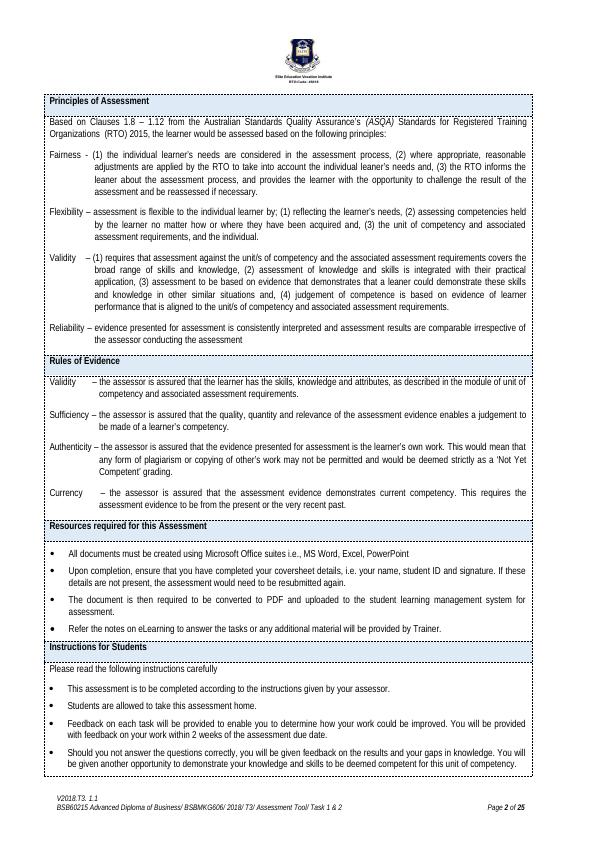
If you are not sure about any aspect of this assessment, please ask for clarification from your assessor.
Please refer to the College re-assessment and re-enrolment policy for more information.
Procedures and Specifications of the Assessment
Task 1
To complete the unit requirements safely and effectively, the individual must:
Define international marketing
Identify international trade patterns
Explain international trade policies and agreements
Identify legislative requirements
Task 2
Using an Australian company, identify two markets which would most likely be a market that they could expand their e-commerce
business to. Using the Australian Trade and Investment Commission (AUSTRADE), learners are to conduct an initial assessment of
a market analyses to support a proposed international market to be selected (bullet points) that address on the following elements:
Estimate the impact of patterns, policies and agreements on the business opportunities
Identify the political, legal, economic, cultural factors for each country identified
Estimate the impact of these factors on the business (as much as possible given limited access to the Australian
company’s information).
Estimate the ease of entering and trading in each market.
Analyse the political and financial stability and the risk of corruption of each country identified.
Analyse the main legal and regulatory requirements and trade barriers for each country identified.
Rate the acceptability of the risks, regulatory requirements and trade barriers.
Consider the impact of risk factors in light of international business cycles and economic conditions
Summarize current market trends including key industry areas, significant trade partnerships, and consumer
characteristics (such as preferences, segmentation, purchasing patterns, etc.)
Identify any new or emerging opportunities to enter, shape or influence the market.
Estimate the contribution these opportunities could present to the business (as much as possible given limited access to
the Australian company’s financial information).
Discuss the fit of these opportunities with direction and goals of the business
V2018.T3. 1.1
BSB60215 Advanced Diploma of Business/ BSBMKG606/ 2018/ T3/ Assessment Tool/ Task 1 & 2 Page 3 of 25
Please refer to the College re-assessment and re-enrolment policy for more information.
Procedures and Specifications of the Assessment
Task 1
To complete the unit requirements safely and effectively, the individual must:
Define international marketing
Identify international trade patterns
Explain international trade policies and agreements
Identify legislative requirements
Task 2
Using an Australian company, identify two markets which would most likely be a market that they could expand their e-commerce
business to. Using the Australian Trade and Investment Commission (AUSTRADE), learners are to conduct an initial assessment of
a market analyses to support a proposed international market to be selected (bullet points) that address on the following elements:
Estimate the impact of patterns, policies and agreements on the business opportunities
Identify the political, legal, economic, cultural factors for each country identified
Estimate the impact of these factors on the business (as much as possible given limited access to the Australian
company’s information).
Estimate the ease of entering and trading in each market.
Analyse the political and financial stability and the risk of corruption of each country identified.
Analyse the main legal and regulatory requirements and trade barriers for each country identified.
Rate the acceptability of the risks, regulatory requirements and trade barriers.
Consider the impact of risk factors in light of international business cycles and economic conditions
Summarize current market trends including key industry areas, significant trade partnerships, and consumer
characteristics (such as preferences, segmentation, purchasing patterns, etc.)
Identify any new or emerging opportunities to enter, shape or influence the market.
Estimate the contribution these opportunities could present to the business (as much as possible given limited access to
the Australian company’s financial information).
Discuss the fit of these opportunities with direction and goals of the business
V2018.T3. 1.1
BSB60215 Advanced Diploma of Business/ BSBMKG606/ 2018/ T3/ Assessment Tool/ Task 1 & 2 Page 3 of 25
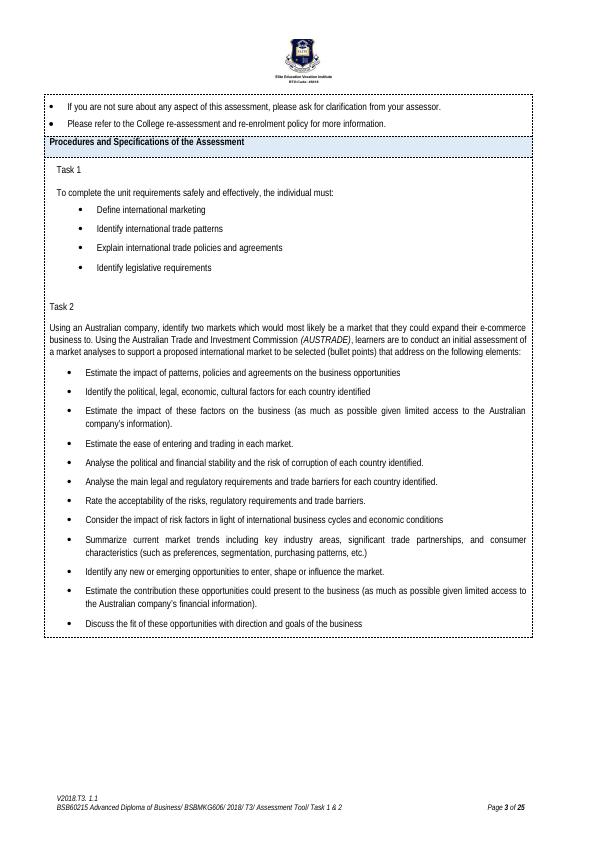
Task 1
1. Before considering international marketing, an organization must ensure that there is business viability to
pursue a marketing opportunity in order to achieve its return on investment (ROI). Provide a brief explanation on
the following:
i. Monetary cost
It is the cost which a consumer spends to purchase goods and services using cash. This is
known as monetary cost. The money which the organisation will spend to ensure the business
viability is monetary cost.
ii. Time cost
The time involved in purchasing a product or manufacturing a product, the time involved is called
time cost. It is because the time which was invested in that particular product could have been
invested somewhere else. The time which the organization will spend in determining the
business viability is known as time cost.
iii. Risk factors
Since the business is undertaking a business viability to determine a marketing opportunity,
various risk factors are encountered in the process which need to be addressed. These risk
factors may vary in nature and differ from business to business and each have to be addressed
carefully.
iv. Competition in
internal market
The business viability can be helpful to understand the competition in the internal market faced
by the company. This helps to formulate a marketing strategy to tackle competition.
v. Current market
share
The current market share is important factor while deciding the marketing strategy as it would
help to know how much the product is popular in the market place. If the product is very popular
a conservative marketing would be done .
vi. Estimated impact of
marketing
opportunity
If the product is a unique one and is very easily substituted then extensive marketing would leak
the idea and any competitor can replicate the product. This would create competition before
the success of the product.
V2018.T3. 1.1
BSB60215 Advanced Diploma of Business/ BSBMKG606/ 2018/ T3/ Assessment Tool/ Task 1 & 2 Page 4 of 25
1. Before considering international marketing, an organization must ensure that there is business viability to
pursue a marketing opportunity in order to achieve its return on investment (ROI). Provide a brief explanation on
the following:
i. Monetary cost
It is the cost which a consumer spends to purchase goods and services using cash. This is
known as monetary cost. The money which the organisation will spend to ensure the business
viability is monetary cost.
ii. Time cost
The time involved in purchasing a product or manufacturing a product, the time involved is called
time cost. It is because the time which was invested in that particular product could have been
invested somewhere else. The time which the organization will spend in determining the
business viability is known as time cost.
iii. Risk factors
Since the business is undertaking a business viability to determine a marketing opportunity,
various risk factors are encountered in the process which need to be addressed. These risk
factors may vary in nature and differ from business to business and each have to be addressed
carefully.
iv. Competition in
internal market
The business viability can be helpful to understand the competition in the internal market faced
by the company. This helps to formulate a marketing strategy to tackle competition.
v. Current market
share
The current market share is important factor while deciding the marketing strategy as it would
help to know how much the product is popular in the market place. If the product is very popular
a conservative marketing would be done .
vi. Estimated impact of
marketing
opportunity
If the product is a unique one and is very easily substituted then extensive marketing would leak
the idea and any competitor can replicate the product. This would create competition before
the success of the product.
V2018.T3. 1.1
BSB60215 Advanced Diploma of Business/ BSBMKG606/ 2018/ T3/ Assessment Tool/ Task 1 & 2 Page 4 of 25
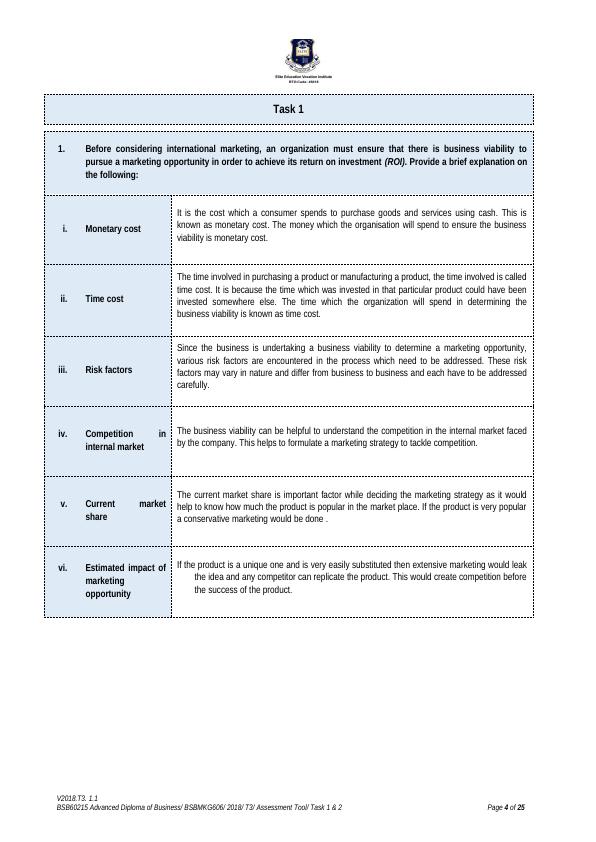
2. When determining an organization’s strategic position, the most common strategy tool is the SWOT analysis –
Strengths, Weaknesses, Opportunities and Threats. Provide a brief discussion on how the use of this analysis tool
would enable the organization to aid its business expansion decision.
i. Strengths
The strength of swot analysis can be used by the organisation to focus on its strength as it gets
highlighted and to use it in expanding its business. The firm becomes aware of its strength and
might work to improve on it so the firm has its competitive advantage.
ii. Weaknesses
The weakness highlighted by swot analysis can be minimized beforehand so they don’t become
a problem. The company can work on the solution and try to find a remedy of the problem
highlighted by the SWOT.
iii. Opportunities
It inlays out all the opportunity which the firm has available or can generate in future. This in turn
will help the organization to be ready and prepare for the opportunity available and do not lose it.
It also helps the firm understand whether it is capable of taking advantage of the opportunity
generated.
iv. Threats
The threats are generated by the external factors which pose a serious risk to the business now
or maybe in future. Analysing the threats before enables the company to counter it with suitable
measures.
3. Changes in your business environment can create great opportunities for your organization – and cause
significant threats. Discuss how the use of PEST analysis is able to identify ‘Big Picture’ opportunities and
threats.
i. Politics
The nature of politics which might affect the business decision is done in the pest analysis to
determine the political threats which a company might face. The company can then try to avoid
the political factor or try and adapt to the new political environment.
ii. Economic
These are the financial factors or threats which is created by the firm’s competitors. The
competitors might take out a new product or enter into a new deal. This all creates a threat
for the organization which it can avert by entering a trade which counteracts this threat.
iii. Social This focuses on social changes which occur in the society. This creates an opportunity and
sometimes threat for the organization which it needs to address accordingly
iv. Technological
The technological factors that affect the organization or a change in technology and norms which
are going to affect the business in the future can act as a threat or opportunity for the
business. The company can act upon it finding alternatives or adapting to the new
technology.
V2018.T3. 1.1
BSB60215 Advanced Diploma of Business/ BSBMKG606/ 2018/ T3/ Assessment Tool/ Task 1 & 2 Page 5 of 25
Strengths, Weaknesses, Opportunities and Threats. Provide a brief discussion on how the use of this analysis tool
would enable the organization to aid its business expansion decision.
i. Strengths
The strength of swot analysis can be used by the organisation to focus on its strength as it gets
highlighted and to use it in expanding its business. The firm becomes aware of its strength and
might work to improve on it so the firm has its competitive advantage.
ii. Weaknesses
The weakness highlighted by swot analysis can be minimized beforehand so they don’t become
a problem. The company can work on the solution and try to find a remedy of the problem
highlighted by the SWOT.
iii. Opportunities
It inlays out all the opportunity which the firm has available or can generate in future. This in turn
will help the organization to be ready and prepare for the opportunity available and do not lose it.
It also helps the firm understand whether it is capable of taking advantage of the opportunity
generated.
iv. Threats
The threats are generated by the external factors which pose a serious risk to the business now
or maybe in future. Analysing the threats before enables the company to counter it with suitable
measures.
3. Changes in your business environment can create great opportunities for your organization – and cause
significant threats. Discuss how the use of PEST analysis is able to identify ‘Big Picture’ opportunities and
threats.
i. Politics
The nature of politics which might affect the business decision is done in the pest analysis to
determine the political threats which a company might face. The company can then try to avoid
the political factor or try and adapt to the new political environment.
ii. Economic
These are the financial factors or threats which is created by the firm’s competitors. The
competitors might take out a new product or enter into a new deal. This all creates a threat
for the organization which it can avert by entering a trade which counteracts this threat.
iii. Social This focuses on social changes which occur in the society. This creates an opportunity and
sometimes threat for the organization which it needs to address accordingly
iv. Technological
The technological factors that affect the organization or a change in technology and norms which
are going to affect the business in the future can act as a threat or opportunity for the
business. The company can act upon it finding alternatives or adapting to the new
technology.
V2018.T3. 1.1
BSB60215 Advanced Diploma of Business/ BSBMKG606/ 2018/ T3/ Assessment Tool/ Task 1 & 2 Page 5 of 25
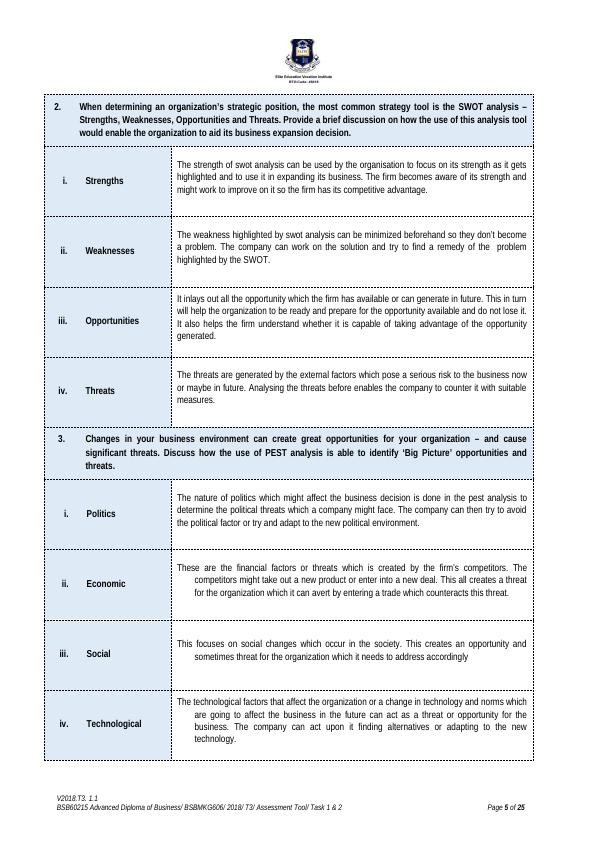
4. Without setting clear performance goals, employees may feel aimless about prioritizing and completing their
work and disengaged in their jobs, and teams can become mired in confusion, misunderstandings, and conflict.
Provide a brief discussion on the use of the SMART model as a goal-setting tool.
i. Specific
The goals of the business need to be specific and to be exact, precise, realistic and properly
framed.
ii. Measurable
A goal should be measurable and with a specific time since as the deadline approaches the goal
seems achievable. It also acts as a motivational factor as people get excited when they see their
goal is getting achieved before the deadline.
iii. Achievable
The goal which had been set should be realistic and achievable and we can account for it in a
specific time.
iv. Relevant
The goal should be relevant and deliverable as it is an important part. If a goal which has been
set is unrealistic and cannot be delivered would be a failure of this model.
v. Timed
The timing of the goal is the most important as the time set to achieve a particular goal should
be sufficient for that particular goal to be attained.
5. The nature and extent of goals for international market should take into consideration of several factors. Briefly
discuss on the following:
i. The differing needs
of consumers
The consumers around the globe have different needs. This creates a diversification among the
consumers base and there is delay in reaching the goals by the organization as it may have to
satisfy each and every consumers.
ii. Existing
competition
The goals of an organization may not be achieved if there is a lot of competition in the
international market. This creates a delay in achieving the goals as the company has to tackle
the competition with counteracting strategies which hinders a bit to pursue the goal.
iii. Trade barriers/
protectionist
arrangements
Trade barriers in international trade affect the company in achieving the goals as it produces a
hindrance in selling its products to the other countries. Trade barriers hamper the growth and are
responsible for stopping international trade.
V2018.T3. 1.1
BSB60215 Advanced Diploma of Business/ BSBMKG606/ 2018/ T3/ Assessment Tool/ Task 1 & 2 Page 6 of 25
work and disengaged in their jobs, and teams can become mired in confusion, misunderstandings, and conflict.
Provide a brief discussion on the use of the SMART model as a goal-setting tool.
i. Specific
The goals of the business need to be specific and to be exact, precise, realistic and properly
framed.
ii. Measurable
A goal should be measurable and with a specific time since as the deadline approaches the goal
seems achievable. It also acts as a motivational factor as people get excited when they see their
goal is getting achieved before the deadline.
iii. Achievable
The goal which had been set should be realistic and achievable and we can account for it in a
specific time.
iv. Relevant
The goal should be relevant and deliverable as it is an important part. If a goal which has been
set is unrealistic and cannot be delivered would be a failure of this model.
v. Timed
The timing of the goal is the most important as the time set to achieve a particular goal should
be sufficient for that particular goal to be attained.
5. The nature and extent of goals for international market should take into consideration of several factors. Briefly
discuss on the following:
i. The differing needs
of consumers
The consumers around the globe have different needs. This creates a diversification among the
consumers base and there is delay in reaching the goals by the organization as it may have to
satisfy each and every consumers.
ii. Existing
competition
The goals of an organization may not be achieved if there is a lot of competition in the
international market. This creates a delay in achieving the goals as the company has to tackle
the competition with counteracting strategies which hinders a bit to pursue the goal.
iii. Trade barriers/
protectionist
arrangements
Trade barriers in international trade affect the company in achieving the goals as it produces a
hindrance in selling its products to the other countries. Trade barriers hamper the growth and are
responsible for stopping international trade.
V2018.T3. 1.1
BSB60215 Advanced Diploma of Business/ BSBMKG606/ 2018/ T3/ Assessment Tool/ Task 1 & 2 Page 6 of 25
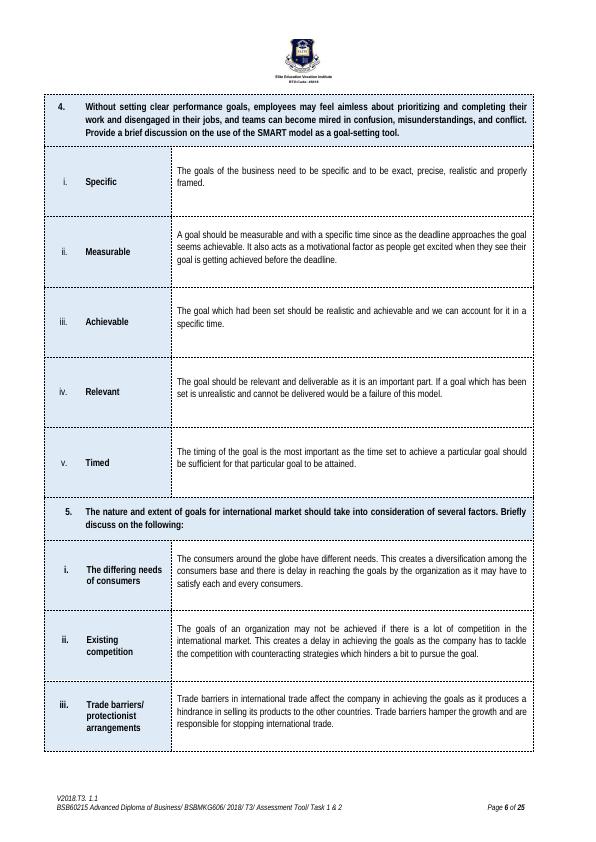
End of preview
Want to access all the pages? Upload your documents or become a member.
Related Documents
BSBHRM501 Manage Human Resource Services Assessment Task 1lg...
|25
|4969
|205
Lead and Manage Organisational Change Assessment 2022lg...
|22
|5478
|16
BSBMKG502 Establish and Adjust the Marketing Mix Assessment 2022lg...
|18
|5401
|31
BSBADM502 Manage Meetings Assessment Task 1 and Task 2lg...
|26
|5176
|204
BSB50215 Diploma of Business Assessment 2022lg...
|26
|5286
|21
BSB60215 Advanced Diploma of Business Tasks 2022lg...
|22
|5451
|14
